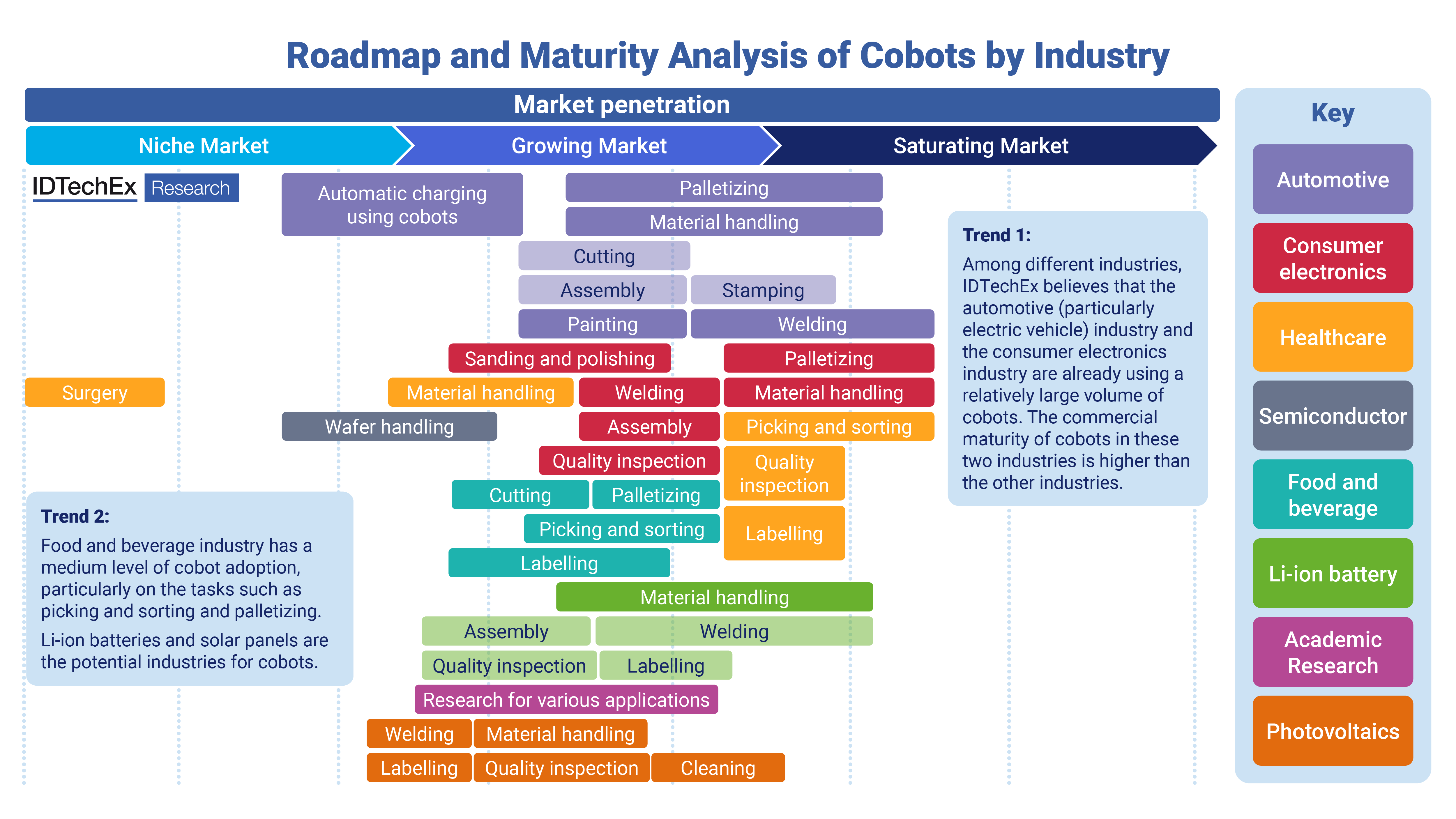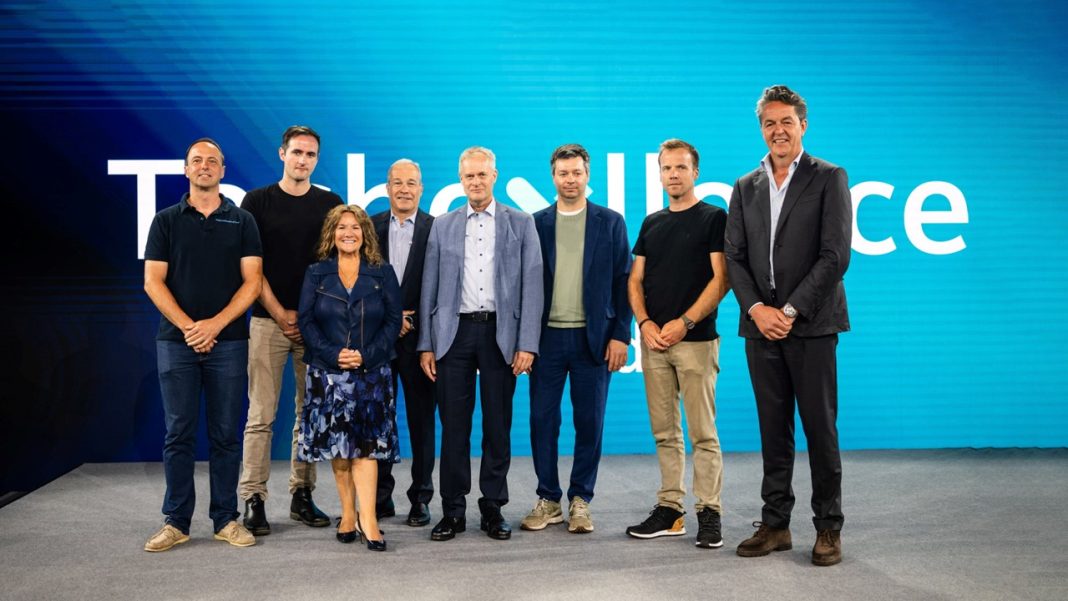Collaborative robots (cobots) have transformed manufacturing, with their market projected to grow from US$1.2 billion in 2023 to US$29.8 billion by 2035, at a CAGR of 34.5% based on IDTechEx’s analysis. Unlike traditional industrial robots, which operate in isolated, caged environments for safety, cobots work alongside humans, enhancing flexibility and reducing downtime. This shift aligns with Industry 5.0, emphasizing human-machine synergy, personalization, and smart factory ecosystems driven by artificial intelligence (AI), machine vision, and reshoring trends (a movement favoured by the Trump administration). IDTechEx’s research report “Collaborative Robots 2025-2045: Technologies, Players, and Markets” details the technical, commercial and regulatory factors and barriers on cobotics.
Industry 5.0 and Cobot Integration
Industry 5.0 prioritizes human-robot collaboration, moving beyond Industry 4.0’s automation focus. Cobots enable this by performing tasks requiring precision and speed while humans handle decision-making and customization. In automotive manufacturing, companies like BMW and Ford have integrated cobots into assembly lines, reducing cycle times by up to 20% and cutting operational costs by 15%. Beyond automotive, electronics (e.g., microchip assembly, wafer transportation), food and beverage (e.g., packaging), and healthcare (e.g., lab automation) sectors are adopting cobots, with over 60% of global cobot deployments occurring in these industries. This versatility drives cobot demand, with 73,000 units shipped globally in 2025, a 31% increase from 2024.

Machine Vision: Enhancing Precision and Safety
Machine vision is critical to cobot functionality, enabling real-time object recognition and environmental adaptation. High-resolution RGB and time-of-flight (ToF) cameras, like those in TM Robot’s cobots, capture 2D and 3D data, achieving object recognition accuracy of 95% and depth measurement errors below 10%. In electronics, cobots with vision systems inspect microchips, reducing defect rates by 30% compared to human inspection. ToF sensors create detailed depth maps, enabling complex tasks like 3D surface defect detection and collision avoidance. For mobile cobots, vision systems integrate with lidar and ultrasonic sensors, ensuring safe navigation in dynamic environments, with obstacle detection response times under 100ms.
AI: Driving Intelligence and Adaptability
AI enhances cobots’ decision-making and interaction capabilities. Deep learning algorithms, trained on datasets of 10,000+ images, enable cobots to recognize diverse objects with 98% accuracy, critical for warehouse automation where occlusion challenges arise (e.g., overlapping items in bins). Natural language processing (NLP) allows cobots to process verbal commands, though ambient noise reduces accuracy by 15% in factory settings (MIT, 2025). Advanced AI models, like those on Nvidia’s Jetson platform, process 1TB/s of sensor data, enabling real-time adaptive workflows and predictive maintenance, which cuts downtime by 25% (Nvidia, 2024). Universal Robots’ PolyScope X platform, leveraging Nvidia’s Isaac libraries, supports complex tasks like autonomous path planning, with a 40% improvement in task efficiency.
Hardware and Software Innovations
Cobot advancements stem from modular hardware and software upgrades rather than new physical designs. Sensor arrays (cameras, ToF, lidar) cost US$500-$2,000 per unit, while Nvidia Jetson modules ($400-$1,200) provide the computational power for AI tasks. Modular end-of-arm tooling (EoAT), priced at US$1,000-$5,000, allows task-specific customization, such as precision grippers for healthcare applications like medical device assembly. Software platforms, like Universal Robots’ PolyScope, optimize data processing, reducing latency by 30% for real-time applications. These innovations enable cobots to integrate seamlessly into existing production lines, with setup times reduced to 2-4 hours.
Commercial Insights and Market Readiness
The cobot market’s growth is driven by cost savings and flexibility. A single cobot, priced at US$20,000-$40,000, offers end-users a 12-30 months return on investment (ROI), compared to 36-60 months for traditional robots. Due to their controlled environments, the electronics and automotive sectors lead adoption, accounting for 55% of the market share. Reshoring trends, particularly in the U.S. and EU, boost demand, with 70% of manufacturers planning to integrate cobots by 2030 to reduce labor costs, which average US$25/hour in developed markets. This transition is expected to push the adoption of cobots. More details can be found in IDTechEx’s research report “Collaborative Robots 2025-2045: Technologies, Players, and Markets”.
Conclusion
Cobots are revolutionizing automation by combining human ingenuity with robotic precision. Machine vision and AI advancements enable 95%+ accuracy in object recognition and 25% reductions in downtime, while modular designs and software upgrades ensure adaptability. With a projected US$29.8 billion market by 2035, cobots are poised to dominate smart factories, driving efficiency, safety, and customization across industries.
For more information on this report, including downloadable sample pages, please visit www.IDTechEx.com/Cobots, or for the full portfolio of robotics-related research available from IDTechEx, see www.IDTechEx.com/Research/Robotics.
About IDTechEx
IDTechEx provides trusted independent research on emerging technologies and their markets. Since 1999, we have been helping our clients to understand new technologies, their supply chains, market requirements, opportunities and forecasts. For more information, contact research@IDTechEx.com or visit www.IDTechEx.com.




